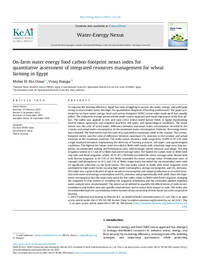On-farm water energy food carbon-footprint nexus index for quantitative assessment of integrated resources management for wheat farming in Egypt

Authors:
To improve the farming efficiency, Egypt has been struggling to narrow the water, energy, and yield gaps owing to exacerbated water shortage. For quantitative diagnosis of farming performance, the paper presented an on-farm water, energy, food, and carbon-footprint (WEFC) nexus index made up of four equally pillars. The arithmetic average preserved the multi-centric approach and equal importance of the four pillars.
The index was applied to test and rank 2,042 wheat-based farmer fields in Egypt representing diverse inputs, agronomic and irrigation practices, soil types, and agroecological conditions. The water metric was the ratio of saved water, difference between maximum water consumption recorded in the country and actual water consumption, to the maximum water consumption. Likewise, the energy metric was obtained. The food metric was the ratio of actual yield to maximum yield in the country. The carbon footprint metric was the ratio of difference between maximum CO2 emission in the country and actual emission to the maximum emission. The index values showed a wide range from 18.69% to 87.33% with a high standard deviation emphasizing the diversity of farming practices, soil types, and agroecological conditions. The highest ten values were recorded in fields with sandy soils, relatively large area, drip irrigation,
recommended seeding and fertilization rates, well drainage, weeds removal, and tillage. The drip irrigation system in 51 out of 52 fields had above average value. The lowest ten values were in fields with clay soils and flood irrigation, where 18.7% of 1,780 fields exceeded the above average value. Raised beds
with furrow irrigation in 83.15% of 184 fields exceeded the above average value. Fertilization rates of nitrogen and phosphorus in 61% and 53% of fields respectively exceeded the recommended rates with no significant reflection on the food metric. The low index values in fields with flood irrigation were
attributed to high water losses causing high water consumption, energy consumption, and CO2 emission.
The index was a good indicative of input resources consumption and output production as it varied inversely with water and energy consumption and CO2 emission and proportionally with yield. Since the highwater consumption was the main entry point for low index values in fields with flood irrigation, changing
the irrigation to drip system or revisiting the irrigation scheduling and the estimated applied irrigation water amount were recommended. The index can be utilized to quantify the effectiveness of both recommendations and further new site-specific interventions and to assess their impact at scale. The index also
recommended land use consolidation where farmers retain ownership of their lands but with cooperative farming.
